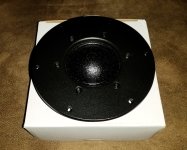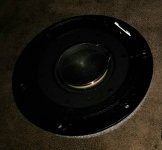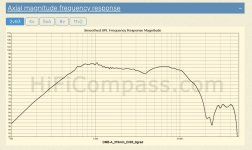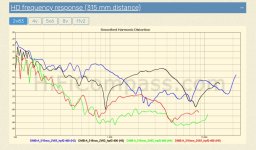Agreed in premise Dave, and my actual listening experience has shown me that above 5khz, the combing isn‘t audible if the listening distance is 10x the point source area…..the drivers sum precisely and the phase patterns more or less move towards quadrature for our intent and purposes………thankfully due to the really short wavelengths. And certainly, none of this is any more detrimental than whizzer cones or odd shaped phase plugs…..more tradeoffs.Ideal is a quarter wavelength at the XO point.
At 5kHz that is about 1.7cm.
What you get is combing (It looks worse than it sounds) which will limit the sweet spot.
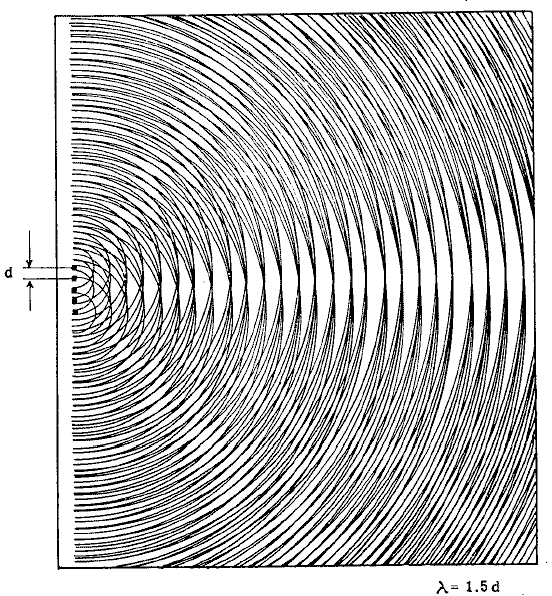
Note that quarter wavelength at 700 Hz is just over 12 cm, you likely can’t get the mids close enuff to the woofers to meet the quarter wavelength criteria.
Most multiways fail the C-C ideal criteria and it becomes one of the compromises one makes when designing a loudspeaker.
dave
Thanks for sharing your experiences with these various domes……the Dayton silk dome certainly is deceiving then….on paper for less than $50, it sure seems quite the bargainThe Hivi DMB-A is better than the Dayton RS52-FN and costs under $30. The problem with the RS52 is the excess hash in the CSD and high odd order HD across the board.
The Hivi DM7500 has an unworkable FR curve and consequently phase issues across the upper register. Definitely not worth the $100 price tag.
The only 3" dome I'd consider is the ScanSpeak D7608-9200, despite a few strong opinions that it doesn't have enough lower mid capability due to excursion limits. The main issue with this mid is the high Qts and open back venting which needs the appropriate sized aperiodic dampened back chamber to work well. The Qts can be lowered to .75 and it can be crossed at 700 3rd order with a very clean CSD and low odd order HD. Do not think of using it without a chamber, even as a dipole.
The Morel MDM55 (CAM558) is another great dome mid. It can be crossed around 800 3rd order or around 900 2nd order. The top end is very smooth and rather detailed. Upper useful limit is 4k with a 2nd order LP and works well with a 19mm HF dome. It happens to work best with the CAT378, which lines up acoustic centers perfectly. Expect roughly 88 dB/W after xover or 92 dB/W for 2 of them. You'll have to cross around 3k if using an MTM configuration and slightly overlap driver flanges to reduce CTC spacing.
The Morel EM1308 is very similar to the MDM55 and you'd be hard pressed to hear the difference. The faceplate helps with dispersion, but it also adds some diffraction artifacts due to this. It sounds just a tick cleaner in the lower mids, but the slightly better performance isn't worth the extra cost. The large flange also makes tighter CTC spacing harder based on the typical LP used with these smaller mids. I'd prefer the smaller MDM55 due to this reason.
A ribbon or AMT tweeter would work better in MTM with two mid domes due to narrow HF vertical dispersion, reducing combing effects compared to wider radiation of HF domes. This can be a problem for people who prefer a taller HF sweet spot, but it really works well with highly reflective ceilings and floors.
And I’d accept the compromise on the upper end Xo point if two of these Morel domes can cross lower, say 500hz LR4 OR 900hz 1st order……it would be nice to have near perfect phase summing from 30-3000hz with my Faital 15pr400 woofers.
I can see why 1.4” compression drivers all all the rage these days given a passband of 700hz all the way up to 12khz or so……there‘s no musical content beyond that anyways, just odd harmonics.
On a side note, there’s apparently been a few uses of 3” diaphragm compression drivers used in an odd way…..remove the back cup and face the driver that way…….very clean output from 700hz to 4khz without the hassle of a large horn.
The DMB-A is an excellent driver for under $30. Its 91 dB sensitivity and images beautifully in the mids. I would mate it with a good ribbon / planar, but it would also go well with a metal or soft dome.
I would advise against an offset MTM arrangement using a higher xover to HF due to the vertical dispersion characteristics. The sharp shift in radiation pattern will create a nasal sounding off axis response and it will be dependent on the horizontal listening window. I'd rather accept the combing around tweeter xover, which in reality won't be as bad as some think.
Running two Morel MDM55 or CAM558 would make a lower xover possible than with just one dome, but I'm not sure how low you could push the xover based on how much you gain from doubling the driver radiating area. I'd have to sim it in VituixCad to find out. 500 hz would be pushing it IMO unless you're ok with less max SPL.
Indeed there's some potential in exploring the use of a large compression driver as a direct radiating dome. I'm sort of in the same boat that way and have done a little preliminary research. The main challenge is having enough VC overhang for lower mid output potential, as most CDs have very little VC overhang. A decent 3" or even 4" phenolic diaphragm driver could deliver acceptable performance depending on a few factors. The cost would definitely make this an attractive option based on the scarce availability of decent larger mid domes.
IMO the SS D7608 is the only better 3" choice around $100 and is still my favorite one for the money. If you look on Hifi Compass, the performance is very good, and if you use 2 in MTM or MMT (one running to upper HF xover point), the extra surface area would compensate for the limited lower mid output vs THD.
I would advise against an offset MTM arrangement using a higher xover to HF due to the vertical dispersion characteristics. The sharp shift in radiation pattern will create a nasal sounding off axis response and it will be dependent on the horizontal listening window. I'd rather accept the combing around tweeter xover, which in reality won't be as bad as some think.
Running two Morel MDM55 or CAM558 would make a lower xover possible than with just one dome, but I'm not sure how low you could push the xover based on how much you gain from doubling the driver radiating area. I'd have to sim it in VituixCad to find out. 500 hz would be pushing it IMO unless you're ok with less max SPL.
Indeed there's some potential in exploring the use of a large compression driver as a direct radiating dome. I'm sort of in the same boat that way and have done a little preliminary research. The main challenge is having enough VC overhang for lower mid output potential, as most CDs have very little VC overhang. A decent 3" or even 4" phenolic diaphragm driver could deliver acceptable performance depending on a few factors. The cost would definitely make this an attractive option based on the scarce availability of decent larger mid domes.
IMO the SS D7608 is the only better 3" choice around $100 and is still my favorite one for the money. If you look on Hifi Compass, the performance is very good, and if you use 2 in MTM or MMT (one running to upper HF xover point), the extra surface area would compensate for the limited lower mid output vs THD.
On a side note, there’s apparently been a few uses of 3” diaphragm compression drivers used in an odd way…..remove the back cup and face the driver that way…….very clean output from 700hz to 4khz without the hassle of a large horn.
I tied that once, while ago, with old onkyo compression mid. Removing the back chamber allows more excursion, but it leads to higher distortion as the surround was never designed for it.
BTW, I'm currently working on a small write up of the SS D7608 to help others here with how to implement it for the best possible performance. Its a touchy animal, in that it requires a specific rear chamber configuration to perform at its best. This is what makes or breaks it in the real world. I can see why many people don't like it when used as an open back driver in OB setup. It really needs a properly dampened chamber.
As a better small format soft dome to obtain tight CTC spacing, I prefer the SB29RDNC. The next best one is the SB26STCN, which has a little more HD in the lower mids and a bit lower sensitivity. Its still a very good soft dome, especially for the cost.
what about 2 square morel domes exactly next to each other then a tweeter above then two domes side by side again ?
mm
t
mm
would they work well so close together or would the sound diffraction off the dome next to it ?
does anybody think that would let you cross to a woofer a bit lower
mm
t
mm
would they work well so close together or would the sound diffraction off the dome next to it ?
does anybody think that would let you cross to a woofer a bit lower
the listening distance is 10x
Simple geometry. The further away you are the larger the coherenet bubble you are listening in.
And the human ear/brain is well trained at ignoring combing.
dave
Put two inverted dome drivers , the Dayton Sig120-4 , in series (halving distortion) to get 8 Ohm and have a happy DIY life!
What do you expect to get from ridiculous expensive drivers?
I have three Stax Lambda pro headphones (active/passive driven) and there is nothing fancy about their sound that I miss in well build speakers!
Sometimes I have the imagination that the IQ-factor and some DIY acrobats are mutual exclusive conditions for peace of mind 🙂
What do you expect to get from ridiculous expensive drivers?
I have three Stax Lambda pro headphones (active/passive driven) and there is nothing fancy about their sound that I miss in well build speakers!
Sometimes I have the imagination that the IQ-factor and some DIY acrobats are mutual exclusive conditions for peace of mind 🙂
I've never seen the Waterfall or Distortion plots of the Sig120, Have you?
You think thats, expensive? but have 3, 1500 dollar headphones?🤔
The DIY acrobat and the IQ acrobat are indeed the same archetype. Each are over compensating, or possibly trying to appear superior because they have or know something that someone else doesn't 😉
"If you are experiencing distress or negative impacts due to perfectionistic tendencies, it may be beneficial to seek support from a mental health professional who can provide guidance and help develop healthier coping strategies"
You think thats, expensive? but have 3, 1500 dollar headphones?🤔
The DIY acrobat and the IQ acrobat are indeed the same archetype. Each are over compensating, or possibly trying to appear superior because they have or know something that someone else doesn't 😉
"If you are experiencing distress or negative impacts due to perfectionistic tendencies, it may be beneficial to seek support from a mental health professional who can provide guidance and help develop healthier coping strategies"
Correction/Information : All my Staxes are bought used from first owners , one of them is indeed the old pro expensive version with gold printed headband (in very good condition the whole unit) but the electronic active device is only the standard one that comes with the cheaper models . The sound difference between active and passive units are very minor , hard to detect ...
The 3rd Stax HP is a single unit (standard model .. 204 or so) that need minor refurbishing which I did by myself with success . I replaced the microperforated protection foil (against moisture etc) with uncoated 6um Mylar foil the stuff they use for electrostatic loudspeakers (DIY) , but only the front side was serviced!
I could have done more intelligently an alternative route by removing both microperforated foils , but need then to open the cans , reverse mounting the driving unit and reversing also two of the color-coded wires to get the absolute phase in the correct state back again! (the stax cans are very easy to modify all is easy to access and very robustly build)
But much more effort so I choosed the simple mod with the 6um Mylar on one side with normal stretching by hand .
The result is such that I can't detect any difference between left and right! (I reversed the can and switched the L/R channels using a preamp , I tried also switching to mono)
The original foil thickness is 2um with gold sputtered on both sides . Makes me really wonder why they brag so boldly about foil thickness everyhere! (everyone thinks thinner is better and the thinnest is reference)
Btw in the measurement sheet done by Stax that comes with the cans the distortion is specified as a freq graph showing THD is under 0.1% but at 120dB sound level!
Not Bad At All 🙂
ps .. THD does not include intermodulation distortion , this is a weak point in fullrange headphones
The 3rd Stax HP is a single unit (standard model .. 204 or so) that need minor refurbishing which I did by myself with success . I replaced the microperforated protection foil (against moisture etc) with uncoated 6um Mylar foil the stuff they use for electrostatic loudspeakers (DIY) , but only the front side was serviced!
I could have done more intelligently an alternative route by removing both microperforated foils , but need then to open the cans , reverse mounting the driving unit and reversing also two of the color-coded wires to get the absolute phase in the correct state back again! (the stax cans are very easy to modify all is easy to access and very robustly build)
But much more effort so I choosed the simple mod with the 6um Mylar on one side with normal stretching by hand .
The result is such that I can't detect any difference between left and right! (I reversed the can and switched the L/R channels using a preamp , I tried also switching to mono)
The original foil thickness is 2um with gold sputtered on both sides . Makes me really wonder why they brag so boldly about foil thickness everyhere! (everyone thinks thinner is better and the thinnest is reference)
Btw in the measurement sheet done by Stax that comes with the cans the distortion is specified as a freq graph showing THD is under 0.1% but at 120dB sound level!
Not Bad At All 🙂
ps .. THD does not include intermodulation distortion , this is a weak point in fullrange headphones
Nothing, if you don't contemplate the use of XX caps and YY inductors in the crossover!What do you expect to get from ridiculous expensive drivers?
Then the resistors...
Except no one wanted to talk about headphones, that in dept.Not Bad At All 🙂
Thats ironicTHD does not include intermodulation distortion
Ok, so back to topic, here's the Hivi DMB-A in the flesh (in pictures lol).
The casting is beautiful, just as good as high dollar Scanspeak or Seas. Aluminum VC former, braided leads and a heavy motor.
The only drawback IMO is insufficient dampening, which can be easily improved. H3 is a bit elevated but should be easily reduced with better pole piece dampening.
All in all not bad for under $30.
The casting is beautiful, just as good as high dollar Scanspeak or Seas. Aluminum VC former, braided leads and a heavy motor.
The only drawback IMO is insufficient dampening, which can be easily improved. H3 is a bit elevated but should be easily reduced with better pole piece dampening.
All in all not bad for under $30.
Attachments
that's pretty interesting! is the dome 3inches im sometimes not sure from reading the description online
Not bad……a little extra damping just might flatten that response as well. Is the rear chamber accessible?Ok, so back to topic, here's the Hivi DMB-A in the flesh (in pictures lol).
The casting is beautiful, just as good as high dollar Scanspeak or Seas. Aluminum VC former, braided leads and a heavy motor.
The only drawback IMO is insufficient dampening, which can be easily improved. H3 is a bit elevated but should be easily reduced with better pole piece dampening.
All in all not bad for under $30.
Tolerances? I always buy 3 drivers and have 3 choices for pairwise selection , the leftover one is for modding or having a spare in case the coil is going up in smoke while my ears having a party 🙂
Btw most (DIY) audio acrobats do not know at which volume knob position the max output level of the amp is reached!
They are really so naive and think "oh my wonderful Yamaha amp delivers 120W RMS at 4 Ohm per channel and it's so brutal loud at the 12 o' clock volume position , why don't I give my neighbours a chance to dance a little more ..."
But OdB FS of the CDP output is typically between 2.2V and 2.4V , most amps need only 200mV , that's more than 20dB difference!
The industry is quite happy about naive customers not knowing where the limits are , and no one tells the customers the truth , oh what a brave new world!
Any dead speaker is a good speaker 🙂
Btw most (DIY) audio acrobats do not know at which volume knob position the max output level of the amp is reached!
They are really so naive and think "oh my wonderful Yamaha amp delivers 120W RMS at 4 Ohm per channel and it's so brutal loud at the 12 o' clock volume position , why don't I give my neighbours a chance to dance a little more ..."
But OdB FS of the CDP output is typically between 2.2V and 2.4V , most amps need only 200mV , that's more than 20dB difference!
The industry is quite happy about naive customers not knowing where the limits are , and no one tells the customers the truth , oh what a brave new world!
Any dead speaker is a good speaker 🙂
- Home
- Loudspeakers
- Multi-Way
- Two dome mids in an MTM arrangement……anyone tried it?
